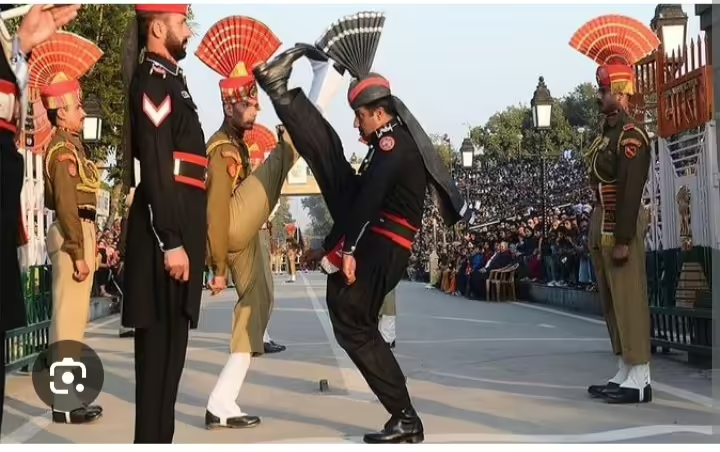Author Hardeep Singh
AMRITSAR When anyone goes to Sri Harmandar Sahib which is also known as Sri Darbar Sahib among Sikh community and ‘Golden Temple’ in the global community, he or she confronts with many individuals wandering on the heritage street, the main passage that leads to the Central Sikh shrine, and saying: “Wagah-border-Wagah-border”.
Most of these people look like drug addicts. In a way, they seem to be spoiling the spiritual atmosphere of one of the most sacred places of the world. It appears that they are hawking in the market. For them, Sri Harmandar Sahib is merely a “tourist place”, nothing else.
They mean to utter “Wagah-border-Wagah-border” that they are trying to woo the devotees and common visitors for a trip to Wagah border, which is the largest joint check post and landport on India-Pakistan international border and situated at around 35 kms from the holy city. They try to lure the people visiting the shrine to watch the 25-minute foot-stomping ‘Beating Retreat’ ceremony of security forces of India and Pakistan during sunset at Wagah border.
They are basically taxi drivers or their agents, who earn money from the Amritsar-Wagah border trip. Trip to Wagah border is also part of the tour packages for Amritsar set by the tour and travel companies. This practice does not only try to convert a religious shrine into a “tourist place”, but also has dire consequences in other senses.
The lowering of the flags ceremony at the Wagah border, which is also called Attari-Wagah border, is a daily military practice that the security forces of India (Border Security Force, BSF) and Pakistan (Pakistan Rangers) have jointly followed since 1959.
However, for the last few decades, it has been used to promote false nationalism, parochialism, fake patriotism and spread hate against Pakistan and its people which are predominantly Muslim followers.
It no longer remains just a parade by security forces of India and Pakistan. Particularly, India has converted it into a big daily event. On January 22, 2019, an upgraded spectator gallery to watch the ‘Beating Retreat’ ceremony was inaugurated by the then Union Home Minister Rajnath Singh.
Besides enhancing its seating capacity to 20,000, the new gallery offers a comfortable view with its horseshoe shape design. The sitting arrangement goes to 32-metre high pedestals. Earlier, the sitting arrangements were limited.
Main motive of enhancing the sitting capacity is to accommodate more and more people so that Indians could outnumber Pakistani nationals sitting on other side of the international border.
Before the start of the ceremony, “patriotic” and “nationalist” songs are played there to incite their sentiments. The BSF deputes its personnel to encourage the Indian spectators to become loud in raising so-called “patriotic” slogans. These personnel work for making blood of the spectators boil with hatred feelings. In a way, they try to project Pakistan and the people sitting on other side of the border in lesser numbers to their enemies.
The spectators often shout hateful “Pakistan-Murdabad” slogans. Indian spectators in Tricolour caps danced for several minutes to the beat of so-called ‘patriotic’ songs, waving the Indian national flag.
The crowd backs Indian soldiers with the slogans of ‘Hindustan Zindabad’, ‘Bharat Mata Ki Jai’, and ‘Vande Mataram’. The aggression rubs on to the Border Security Force (BSF) and it went eyeball to eyeball with Pakistan Rangers during the evening parade along the zero line. The BSF personnel stomp harder and swung their arms more assertively as they march up to the Rangers.
In nutshells, this happens to be a show of spreading hatred against Pakistan.
Most of the spectators are from various states of India, not India-occupied Punjab. When Punjabis see it, they are left in pain as their own brothers are seen sitting on the other side of the border which was drawn during 1947 bloody partition. Half of the portion of Punjab was left in Pakistan during the partition.
Hating Pakistan hurt Punjabis also because land of the neighbouring country is sacred for them. Sikhi’s founder Guru Nanak Sahib’s birth place, Nankana Sahib, and final resting place, Kartarpur Sahib, are situated on the other side of the border.
The spectators take the hatred feelings away with them.
In April, 2023, a woman having Indian flag tricolour painted on her face was allegedly barred from entering Sri Darbar Sahib for violating maryada (Sikh code of conduct). She had returned from the Wagah border after watching the retreat ceremony. Sewadar of the shrine objected to the Indian flag painted on her face. On being asked whether this is not India, the sewadar says, “No, this is Punjab”.
It drew sharp reactions from a section of the users on social media, while the Sikh community backed the act of sewadar citing that the gurdwara is not a “picnic spot” or “tourist place”. The woman later tendered an apology to the Sikh community for attempting to violate the Sikh code of ethics.
Actually, the woman was under the influence of the atmosphere created during the beating retreat ceremony at Wagah border. According to the political thinkers, hate is injected to the people during the ceremony.
To organize this show aimed to promote hatred feelings, the Indian State chose Punjab, homeland of Sikhs. From Punjab they chose Amritsar which is traditional capital of the Sikhs and home of Sri Harmandar Sahib, central Sikh shrine, and Sri Akal Takht Sahib, highest Sikh temporal seat.
Voices have been emerging for long from the pro-people activists of Punjab and different states of India to stop this objectionable and anti-peace practice.
Under the platforms of India-Pakistan Friendship Forum (IPFF), South Asia Free Media Association (SAFMA), Folklore Research Academy (FRA), Punjab Jagriti Manch and several other organizations, activists, veteran journalists, writers and statesmen have raised this issue and submitted memorandum to the BSF authorities and Indian government seeking halting of this practice but the request was never entertained. Instead, the government promotes this event by various public relation exercises such as called movie actors, actresses, celebrities etc.



Leave a Reply